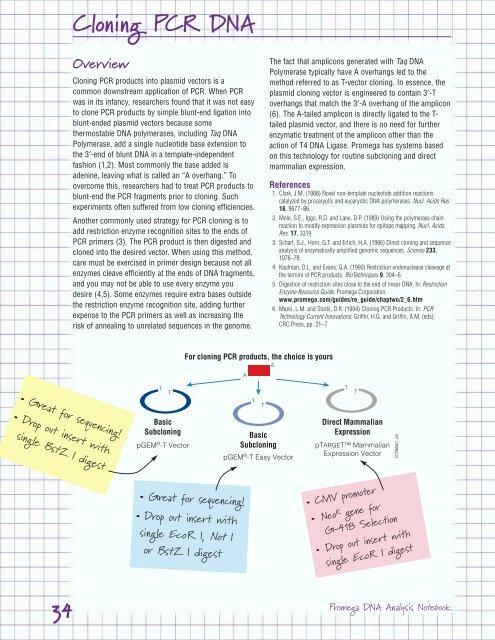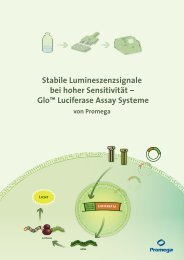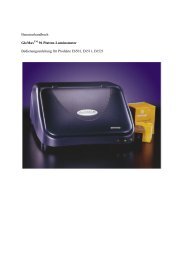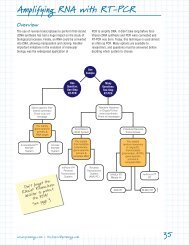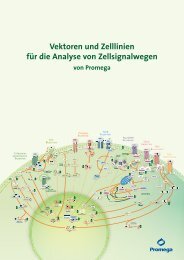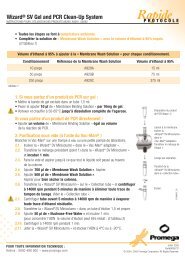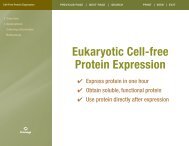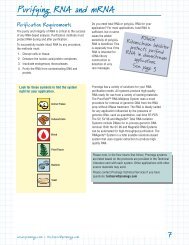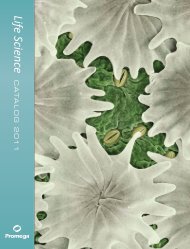DNA Analysis Notebook chapter: Cloning PCR DNA - Promega
DNA Analysis Notebook chapter: Cloning PCR DNA - Promega
DNA Analysis Notebook chapter: Cloning PCR DNA - Promega
Create successful ePaper yourself
Turn your PDF publications into a flip-book with our unique Google optimized e-Paper software.
34<br />
<strong>Cloning</strong> <strong>PCR</strong> <strong>DNA</strong><br />
Overview<br />
• Great for sequencing!<br />
• Drop out insert with<br />
single Bst Z I digest<br />
<strong>Cloning</strong> <strong>PCR</strong> products into plasmid vectors is a<br />
common downstream application of <strong>PCR</strong>. When <strong>PCR</strong><br />
was in its infancy, researchers found that it was not easy<br />
to clone <strong>PCR</strong> products by simple blunt-end ligation into<br />
blunt-ended plasmid vectors because some<br />
thermostable <strong>DNA</strong> polymerases, including Taq <strong>DNA</strong><br />
Polymerase, add a single nucleotide base extension to<br />
the 3′-end of blunt <strong>DNA</strong> in a template-independent<br />
fashion (1,2). Most commonly the base added is<br />
adenine, leaving what is called an “A overhang.” To<br />
overcome this, researchers had to treat <strong>PCR</strong> products to<br />
blunt-end the <strong>PCR</strong> fragments prior to cloning. Such<br />
experiments often suffered from low cloning efficiencies.<br />
Another commonly used strategy for <strong>PCR</strong> cloning is to<br />
add restriction enzyme recognition sites to the ends of<br />
<strong>PCR</strong> primers (3). The <strong>PCR</strong> product is then digested and<br />
cloned into the desired vector. When using this method,<br />
care must be exercised in primer design because not all<br />
enzymes cleave efficiently at the ends of <strong>DNA</strong> fragments,<br />
and you may not be able to use every enzyme you<br />
desire (4,5). Some enzymes require extra bases outside<br />
the restriction enzyme recognition site, adding further<br />
expense to the <strong>PCR</strong> primers as well as increasing the<br />
risk of annealing to unrelated sequences in the genome.<br />
T<br />
T<br />
Basic<br />
Subcloning<br />
pGEM ® -T Vector<br />
For cloning <strong>PCR</strong> products, the choice is yours<br />
• Great for sequencing!<br />
• Drop out insert with<br />
single Eco R I, Not I<br />
or Bst Z I digest<br />
A<br />
T<br />
pGEM ® Basic<br />
Subcloning<br />
-T Easy Vector<br />
T<br />
The fact that amplicons generated with Taq <strong>DNA</strong><br />
Polymerase typically have A overhangs led to the<br />
method referred to as T-vector cloning. In essence, the<br />
plasmid cloning vector is engineered to contain 3′-T<br />
overhangs that match the 3′-A overhang of the amplicon<br />
(6). The A-tailed amplicon is directly ligated to the Ttailed<br />
plasmid vector, and there is no need for further<br />
enzymatic treatment of the amplicon other than the<br />
action of T4 <strong>DNA</strong> Ligase. <strong>Promega</strong> has systems based<br />
on this technology for routine subcloning and direct<br />
mammalian expression.<br />
References<br />
1. Clark, J.M. (1988) Novel non-template nucleotide addition reactions<br />
catalyzed by procaryotic and eucaryotic <strong>DNA</strong> polymerases. Nucl. Acids Res.<br />
16, 9677–86.<br />
2. Mole, S.E., Iggo, R.D. and Lane, D.P. (1989) Using the polymerase chain<br />
reaction to modify expression plasmids for epitope mapping. Nucl. Acids<br />
Res. 17, 3319.<br />
3. Scharf, S.J., Horn, G.T. and Erlich, H.A. (1986) Direct cloning and sequence<br />
analysis of enzymatically amplified genomic sequences. Science 233,<br />
1076–78.<br />
4. Kaufman, D.L. and Evans, G.A. (1990) Restriction endonuclease cleavage at<br />
the termini of <strong>PCR</strong> products. BioTechniques 9, 304–6.<br />
5. Digestion of restriction sites close to the end of linear <strong>DNA</strong>. In: Restriction<br />
Enzyme Resource Guide. <strong>Promega</strong> Corporation.<br />
www.promega.com/guides/re_guide/chaptwo/2_6.htm<br />
6. Mezei, L.M. and Storts, D.R. (1994) <strong>Cloning</strong> <strong>PCR</strong> Products. In: <strong>PCR</strong><br />
Technology Current Innovations. Griffin, H.G. and Griffin, A.M. (eds).<br />
CRC Press, pp. 21–7.<br />
A<br />
T<br />
Direct Mammalian<br />
Expression<br />
pTARGET Mammalian<br />
Expression Vector<br />
T<br />
• CMV promoter<br />
• NeoRgene for<br />
G-418 Selection<br />
• Drop out insert with<br />
single Eco R I digest<br />
<strong>Promega</strong> <strong>DNA</strong> <strong>Analysis</strong> <strong>Notebook</strong><br />
3779MA07_2A
<strong>Cloning</strong> <strong>PCR</strong> <strong>DNA</strong><br />
Basic Subcloning<br />
pGEM ® -T and pGEM ® -T Easy Vector Systems<br />
The most basic need in <strong>PCR</strong> cloning is for simple, general<br />
cloning vectors. The pGEM-T and pGEM-T Easy Vector<br />
Systems (h,i) were designed for just that purpose. The<br />
vectors are based on the pGEM-5Zf(+) Vector (h) backbone.<br />
The pGEM-T and -T Easy Vectors provide convenient T7<br />
and SP6 promoters that serve as sequencing primer<br />
binding sites and also allow in vitro transcription of either<br />
strand of the insert with the appropriate RNA polymerase.<br />
The vectors also have the lacZα coding region, allowing<br />
easy blue/white screening of recombinants. The pGEM-T<br />
and -T Easy Vectors are provided with 2X Rapid Ligation<br />
Buffer, which allows efficient ligation in just 1 hour with the<br />
supplied T4 <strong>DNA</strong> Ligase. You can either supply your own<br />
favorite E. coli competent cells or purchase the system with<br />
<strong>Promega</strong>’s high-efficiency JM109 Competent Cells. The<br />
choice is yours.<br />
Select recombinants by<br />
blue/white selection.<br />
What is Blue/White Selection?<br />
The enzyme β-galactosidase, the product of the<br />
bacterial lacZ gene, can be separated into two<br />
domains—the α-fragment and the ω-fragment. The two<br />
fragments interact to form a functional β-galactosidase.<br />
For blue/white selection, the ω-fragment is expressed<br />
by the E. coli host strain, and the α-fragment is<br />
provided by the cloning vector. An intact, in-frame<br />
α-fragment will interact with the host strain<br />
ω-fragment, creating functional β-galactosidase. This is<br />
known as α-complementation. Bacteria capable of<br />
producing functional β-galactosidase will cleave the<br />
substrate X-Gal (5-bromo-4-chloro-3-indolyl-β-Dgalactopyranoside),<br />
creating blue colonies when grown<br />
on indicator plates containing IPTG and X-Gal (see<br />
recipe on p. 40). Blue/white-capable cloning vectors<br />
have a multiple cloning site within the α-fragment<br />
coding sequence. When your sequence of interest is<br />
inserted within this region, the α-fragment is disrupted,<br />
α-complementation does not occur, and the colony is<br />
white. E. coli (e.g., JM109, DH5α or XL1-Blue)<br />
transformed with an insert-containing plasmid produce<br />
white colonies, while those containing empty or<br />
religated vector produce blue colonies.<br />
pGEM ® -T Vector System I<br />
(you supply the competent cells)<br />
Cat.#: A3600 (20 reactions)<br />
pGEM ® -T Vector System II<br />
(supplied with High Efficiency JM109 Competent Cells)<br />
Cat.#: A3610 (20 reactions)<br />
Protocol:<br />
www.promega.com/tbs/tm042/tm042.html<br />
Citations for use of the pGEM ® -T System online at:<br />
www.promega.com/citations/<br />
Xmn I 1994<br />
Need sequencing-grade plasmid <strong>DNA</strong>?<br />
<strong>Promega</strong> has the system.<br />
Wizard ® Plus SV Minipreps <strong>DNA</strong> Purification System (q,r)<br />
Simple spin preps for plasmid <strong>DNA</strong>. Guaranteed for<br />
fluorescent sequencing.<br />
Cat.#: A1330 (50 preps)<br />
Cat.#: A1460 (250 preps)<br />
Protocol:<br />
www.promega.com/tbs/tb225/tb225.html<br />
www.promega.com • techserv@promega.com 35<br />
Sca I<br />
1875<br />
Amp r<br />
pGEM ® -T<br />
Vector<br />
(3000bp)<br />
ori<br />
Drop out your<br />
insert with a<br />
single Bst Z I<br />
digest.<br />
Nae I<br />
2692<br />
f1 ori<br />
T7<br />
1 start<br />
Apa I 14<br />
Aat II 20<br />
Sph I 26<br />
BstZ I 31<br />
lacZ<br />
T T<br />
Nco I<br />
Sac II<br />
37<br />
46<br />
Spe I 55<br />
Not I 62<br />
BstZ I 62<br />
Pst I 73<br />
Sal I 75<br />
Nde I 82<br />
Sac I 94<br />
BstX I 103<br />
Nsi I 112<br />
SP6<br />
126<br />
➞<br />
➞<br />
0356VA04_3A<br />
Sequence inserts with:<br />
SP6 Promoter Primer<br />
T7 Promoter Primer<br />
pUC/M13 Forward Primer<br />
pUC/M13 Reverse Primer
36<br />
<strong>Cloning</strong> <strong>PCR</strong> <strong>DNA</strong><br />
Sca I 1890<br />
Drop out your<br />
insert with a<br />
single Bst Z I,<br />
Eco R I or<br />
Not I digest.<br />
Number of White Colonies<br />
Xmn I 2009<br />
450<br />
400<br />
350<br />
300<br />
250<br />
200<br />
150<br />
100<br />
50<br />
Amp r<br />
pGEM ® -T Easy<br />
Vector<br />
(3015bp)<br />
ori<br />
f1 ori<br />
Nae I 2707<br />
lacZ<br />
T T<br />
Apa I<br />
Aat II<br />
Sph I<br />
BstZ I<br />
Nco I<br />
BstZ I<br />
Not I<br />
Sac II<br />
EcoR I<br />
Spe I<br />
EcoR I<br />
Not I<br />
BstZ I<br />
Pst I<br />
Sal I<br />
Nde I<br />
Sac I<br />
BstX I<br />
Nsi I<br />
Relationship between incubation time and cloning efficiency using the 2X<br />
Rapid Ligation Buffer and the pGEM-T Easy Vector. The Control Insert <strong>DNA</strong><br />
supplied with the pGEM-T Easy Vector was ligated into the vector using a 1:1 vector:insert<br />
molar ratio. The Rapid Ligation Buffer and T4 <strong>DNA</strong> Ligase were used in ligation reactions,<br />
which were set up at room temperature (24°C) and allowed to proceed from 0.25 to 16<br />
hours. Number of white colonies (transformants) versus time of ligation are shown. This<br />
graph was adapted from Table 2 in Frackman, S. and Kephart, D. (1999) Rapid Ligation for<br />
the pGEM-T and pGEM-T Easy Vector Systems. <strong>Promega</strong> Notes 71, 8–10.<br />
T7<br />
➞<br />
➞<br />
SP6<br />
1<br />
start<br />
14<br />
20<br />
26<br />
31<br />
37<br />
43<br />
43<br />
49<br />
64<br />
70<br />
77<br />
77<br />
88<br />
90<br />
97<br />
109<br />
118<br />
127<br />
141<br />
Sequence inserts with:<br />
SP6 Promoter Primer<br />
T7 Promoter Primer<br />
pUC/M13 Forward Primer<br />
pUC/M13 Reverse Primer<br />
0<br />
0 2 4 6<br />
8<br />
Hours<br />
10 12 14 16<br />
1473VA05_6A<br />
4019MA03_3A<br />
pGEM ® -T Easy Vector System I<br />
(you supply the competent cells)<br />
Cat.#: A1360 (20 reactions)<br />
pGEM ® -T Easy Vector System II<br />
(supplied with High Efficiency JM109 Competent Cells)<br />
Cat.#: A1380 (20 reactions)<br />
Protocol:<br />
www.promega.com/tbs/tm042/tm042.html<br />
Citations for use of the pGEM-T Easy System<br />
online at:<br />
www.promega.com/citations/<br />
For maximum subcloning efficiency, purify the <strong>PCR</strong><br />
product before subcloning. The presence of <strong>PCR</strong><br />
primers and primer-dimers can reduce subcloning<br />
efficiency. See Chapter 3 for more information.<br />
If you do not purify your <strong>PCR</strong> product, at least make<br />
the amplification as specific as possible. The cleaner<br />
the product, the better the ligation efficiency. Try to<br />
avoid production of primer-dimers by optimizing the<br />
amplification reaction conditions. See Chapter 2 for<br />
more information on optimizing <strong>PCR</strong>.<br />
Example of Transformation Efficiency Calculation:<br />
After 100µl competent cells are transformed with<br />
0.1ng uncut plasmid <strong>DNA</strong>, the transformation<br />
reaction is added to 900µl of SOC medium<br />
(0.1ng <strong>DNA</strong>/ml). A 1:10 dilution with SOC medium<br />
(0.01ng <strong>DNA</strong>/ml) is made, and 100µl is plated on<br />
each of two plates (0.001ng <strong>DNA</strong>/100µl). If 200<br />
colonies are obtained (average of two plates), what is<br />
the transformation efficiency?<br />
200cfu × 1ng<br />
0.001ng 10 –3 µg<br />
For maximum efficiency,<br />
use competent cells<br />
capable of at least<br />
1 x 10 8 cfu/µg <strong>DNA</strong>.<br />
= 2 × 10 8 cfu/µg <strong>DNA</strong><br />
<strong>Promega</strong> <strong>DNA</strong> <strong>Analysis</strong> <strong>Notebook</strong>
<strong>Cloning</strong> <strong>PCR</strong> <strong>DNA</strong><br />
Direct Mammalian Expression<br />
pTARGET Mammalian Expression Vector System<br />
The pTARGET Mammalian Expression Vector (i,j) is<br />
designed to streamline your experiments, allowing you<br />
to go from <strong>PCR</strong> and T-vector cloning directly to<br />
expression analysis in a mammalian system. The<br />
pTARGET Vector is based on the popular pCI-neo<br />
Vector (h,j) (Cat.# E1841) and delivers powerful<br />
mammalian expression through the CMV promoter. The<br />
vector also has the neomycin resistance necessary for<br />
G-418 Sulfate selection of stable transformants.<br />
The pTARGET Vector is the only mammalian expression<br />
T-vector offering blue/white selection of recombinants.<br />
The vector contains the lacZ α-peptide fragment to<br />
complement the ω-fragment of lacZ that is expressed in<br />
common E. coli strains like JM109, DH5α and XL-1<br />
Blue. See page 35 for more explanation of blue/white<br />
selection.<br />
Sequence inserts with:<br />
T7 Promoter Primer<br />
pTARGET<br />
Sequencing Primer<br />
pTARGET Mammalian Expression Vector has been used<br />
for transient expression in many cell lines including:<br />
COS-1 SV40-transformed monkey kidney<br />
COS-7 SV40-transformed monkey kidney<br />
H9c2 rat myoblast<br />
McA-RH7777 rat hepatoma<br />
Primary human melanoma<br />
The pTARGET Mammalian Expression Vector has been<br />
used to create stable transfectants by G-418 Sulfate<br />
selection in many cell lines including:<br />
1376 TCC human bladder transitional cell carcinoma<br />
293 human embryonic kidney cell<br />
A549 human adenocarcinoma<br />
CHO Chinese hamster ovary<br />
NIH/3T3 mouse fibroblast<br />
J82 human bladder transitional cell carcinoma<br />
PS120 Chinese hamster lung fibroblast<br />
RAW264.7 mouse monocyte/macrophage cell line<br />
T24 human bladder transitional cell carcinoma<br />
U937 human leukemic cells<br />
See <strong>Promega</strong>’s online citation database for further<br />
examples and details: www.promega.com/citations/<br />
pTARGET Mammalian Expression Vector System<br />
Cat.#: A1410 (20 reactions and 20 transformations<br />
with high-efficiency JM109 Competent Cells)<br />
Protocol:<br />
www.promega.com/tbs/tm044/tm044.html<br />
Citations for use of the pTARGET System online at:<br />
www.promega.com/citations/<br />
Synthetic<br />
poly(A)<br />
Bgl II 5665<br />
SV40 Late<br />
poly (A)<br />
fl ori<br />
SV40 Enhancer/<br />
EarlyPromoter<br />
The pTARGET Vector contains the simian virus 40<br />
(SV40) enhancer and early promoter region<br />
upstream of the neomycin phosphotransferase gene.<br />
The SV40 early promoter contains the SV40 origin of<br />
replication, which will induce transient, episomal<br />
replication of the pTARGET Vector in cells expressing<br />
the SV40 large T antigen such as COS-1 or COS-7<br />
cells (1). Consequently, the copy number of the<br />
vector will increase in these SV40-transformed cell<br />
lines and give higher transient expression than in<br />
other cell types.<br />
1. Gluzman, Y. (1981) SV40-transformed simian cells support the<br />
replication of early SV40 mutants. Cell 23, 175–82.<br />
www.promega.com • techserv@promega.com 37<br />
Amp r<br />
Neo<br />
Sgf I 664<br />
ori<br />
I-Ppo I<br />
CMV<br />
851<br />
Enhancer/Promoter<br />
pTARGET <br />
Vector<br />
(5670bp)<br />
Intron<br />
T<br />
T<br />
lacZ<br />
T7<br />
EcoR I<br />
BamH I<br />
Nhe I<br />
Xho I<br />
Mlu I<br />
Sma I<br />
Kpn I<br />
Sal I<br />
Acc I<br />
Not I<br />
EcoR I<br />
lacZ<br />
➞<br />
T overhangs<br />
Drop out your insert<br />
with a single<br />
Eco R I digest.<br />
The only mammalian<br />
expression T-vector<br />
capable of blue/white<br />
screening.<br />
1250<br />
1256<br />
1264<br />
1270<br />
1276<br />
1293<br />
1301<br />
1303<br />
1304<br />
1311<br />
1318<br />
1505VA07_6A
38<br />
<strong>Cloning</strong> <strong>PCR</strong> <strong>DNA</strong><br />
Direct Mammalian Expression (continued)<br />
pTARGET Mammalian Expression Vector System<br />
Renilla Luciferase Activity<br />
(T.U./plate × 106 )<br />
Firefly Luciferase Activity<br />
(T.U./plate × 106 )<br />
A.<br />
8<br />
7<br />
6<br />
5<br />
4<br />
3<br />
2<br />
1<br />
0<br />
pCI-neo<br />
pTARGET <br />
HeLa NIH3T3<br />
Cells Transfected<br />
Human Growth Hormone<br />
Activity (ng/ml cond. medium)<br />
D. E.<br />
3.5<br />
3<br />
2.5<br />
2<br />
1.5<br />
1<br />
0.5<br />
0<br />
pCI-neo<br />
pTARGET <br />
HeLa NIH3T3<br />
Cells Transfected<br />
β-galactosidase Activity<br />
(units/plate × 10-3 )<br />
140<br />
120<br />
100<br />
Expression of various reporter proteins using either the pTARGET Mammalian Expression Vector or the pCI-neo Mammalian Expression Vector. The pTARGET Vector was<br />
designed from the pCI-neo Vector (Cat.# E1841). Vector sequences for blue/white selection do not interfere with expression. T.U. = Turner light units. Details of this experiment may be found<br />
in Brondyk, B. (1996) pTARGET Vector: A new mammalian expression T-Vector. <strong>Promega</strong> Notes 58, 2–7.<br />
For expression in mammalian systems, your amplicon<br />
should contain an initiation AUG codon and a stop<br />
codon. Ideally the AUG codon is in the context of a<br />
Kozak consensus sequence: (A or G)CCAUGG (1).<br />
Be sure the initiation codon is the first AUG codon<br />
encountered in the sequence.<br />
1. Kozak, M. (1987) At least six nucleotides preceding the AUG initiator<br />
codon enhance translation in mammalian cells. J. Mol. Biol. 196, 947–50.<br />
Need transfection grade plasmid <strong>DNA</strong>?<br />
<strong>Promega</strong> has the system.<br />
Wizard MagneSil Tfx System (s)<br />
For automated 96-well transfection-grade plasmid<br />
<strong>DNA</strong> purification.<br />
Cat.#: A2380 (4 × 96 preps)<br />
A2381 (8 × 96 preps)<br />
Protocol:<br />
www.promega.com/tbs/tb314/tb314.html<br />
For information on automated methods visit:<br />
www.promega.com/automethods/<br />
B.<br />
80<br />
60<br />
40<br />
20<br />
0<br />
60<br />
50<br />
40<br />
30<br />
20<br />
10<br />
0<br />
pCI-neo<br />
pTARGET <br />
HeLa NIH3T3<br />
Cells Transfected<br />
pCI-neo<br />
pTARGET HeLa NIH3T3<br />
Cells Transfected<br />
CAT Activity<br />
(CPM/plate × 106 )<br />
1539MA07_6A<br />
C.<br />
40<br />
35<br />
30<br />
25<br />
20<br />
15<br />
10<br />
5<br />
0<br />
pCI-neo<br />
pTARGET <br />
HeLa NIH3T3<br />
Cells Transfected<br />
Experimental details<br />
available at:<br />
www.promega.com/pnotes/<br />
58/5189a/5189a.html<br />
Learn about transfection and tools available from<br />
<strong>Promega</strong> in the Transfection Guide available online at:<br />
www.promega.com/guides/, or request literature<br />
#BR041 from your local <strong>Promega</strong> representative.<br />
<strong>Promega</strong> <strong>DNA</strong> <strong>Analysis</strong> <strong>Notebook</strong><br />
4432CA
<strong>Cloning</strong> <strong>PCR</strong> <strong>DNA</strong><br />
<strong>PCR</strong> <strong>Cloning</strong> Techniques<br />
Rapid <strong>PCR</strong>-Based Screen for Orientation of Insert<br />
All <strong>Promega</strong> <strong>PCR</strong> cloning vectors have some unique<br />
landmarks, including RNA promoter primer binding sites<br />
allowing easy sequencing of inserts. The primer binding<br />
sites can also be used to rapidly screen for insert<br />
orientation. For example, we cloned a 1.8kb insert into<br />
the pGEM ® -T Easy Vector System (1). The insert could<br />
be oriented in one of two ways—toward the T7<br />
promoter or toward the SP6 promoter:<br />
T7 Orientation<br />
T7 Primer<br />
Forward Primer<br />
T7 1.8kb fragment SP6<br />
SP6 Orientation<br />
T7 Primer Reverse Primer<br />
Reverse Primer SP6 Primer<br />
T7 1.8kb fragment SP6<br />
Forward Primer SP6 Primer<br />
To check for orientation, we performed colony <strong>PCR</strong> with<br />
the T7 Promoter Primer and either the gene-specific<br />
forward <strong>PCR</strong> primer or reverse <strong>PCR</strong> primer. Eight white<br />
colonies with inserts were chosen from the cloning<br />
experiment for orientation analysis. Clones with the T7<br />
orientation will produce the fragment with only the<br />
reverse <strong>PCR</strong> primer, and clones in the opposite (SP6)<br />
orientation will only produce a product with the forward<br />
<strong>PCR</strong> primer as illustrated below.<br />
bp<br />
2,645–<br />
1,605–<br />
1,198–<br />
676–<br />
517–<br />
222–<br />
T7 + For.<br />
M 1 2 3 4<br />
T7 + Rev.<br />
1 2 3 4<br />
Colony <strong>PCR</strong>. Colonies were suspended in 50µl sterile water, boiled for 10 minutes,<br />
centrifuged at 16,000 × g for 5 minutes, and 5µl of the supernatant was used in each<br />
amplification. The <strong>DNA</strong> was amplified by <strong>PCR</strong> in 50µl volumes with 50pmol of each primer<br />
and 1.25 units of <strong>Promega</strong>’s Taq <strong>DNA</strong> Polymerase (Cat.# M1661). After an initial<br />
denaturation of 2 minutes at 94°C, the amplification profile was 35 cycles of denaturation<br />
(94°C for 30 seconds), annealing (55°C for 1 minute) and extension (72°C for 2.5<br />
minutes); <strong>PCR</strong> was concluded with 1 cycle of 72°C for 10 minutes. Amplification products<br />
(8µl) were analyzed on a 1% agarose gel containing ethidium bromide.<br />
Reference<br />
1. Knoche, K. and Kephart, D. (1999) <strong>Cloning</strong> blunt-end Pfu <strong>DNA</strong> polymerasegenerated<br />
<strong>PCR</strong> fragments into pGEM-T Vector Systems. <strong>Promega</strong> Notes 71,<br />
10–13.<br />
2575TA02_9A<br />
2574MB02_9A<br />
Giving Blunt-Ended <strong>DNA</strong> an A-Tail for T-Vector<br />
Subcloning<br />
<strong>PCR</strong> amplicons generated with proofreading<br />
polymerases like Pfu or Tli <strong>DNA</strong> Polymerase are bluntended.<br />
<strong>Promega</strong> has developed an easy method to add<br />
an A-tail to <strong>PCR</strong> products generated using these<br />
polymerases so that they will become suitable<br />
substrates for T-vector cloning. Full details of the<br />
protocol are available in the pGEM-T and pGEM-T Easy<br />
Vector Systems Technical Manual #TM042.<br />
Start with 1–7µl of purified <strong>PCR</strong> fragment generated by a<br />
proofreading polymerase (e.g., Pfu <strong>DNA</strong> Polymerase).<br />
Add 1µl Taq <strong>DNA</strong> Polymerase 10X Reaction Buffer with MgCl 2 .<br />
Add dATP to a final concentration of 0.2mM.<br />
Add 5 units of Taq <strong>DNA</strong> Polymerase.<br />
Add deionized water to a final reaction volume of 10µl.<br />
Incubate at 70°C for 15–30 minutes.<br />
Use 1–2µl in a ligation reaction with<br />
<strong>Promega</strong>’s pGEM ® -T and pGEM ® -T Easy Vector. 2357MA02_9A<br />
An A-tailing procedure for blunt-ended <strong>PCR</strong> fragments.<br />
Ends Left by Various Thermostable Polymerases.<br />
Taq <strong>DNA</strong> Polymerase 3′A overhang*<br />
GoTaq ® <strong>DNA</strong> Polymerase 3′A overhang*<br />
Tfl <strong>DNA</strong> Polymerase 3′A overhang*<br />
Tth <strong>DNA</strong> Polymerase 3′A overhang*<br />
Pfu <strong>DNA</strong> Polymerase Blunt<br />
Tli <strong>DNA</strong> Polymerase Blunt<br />
Long <strong>PCR</strong> mixes Blunt<br />
Proofreading Polymerases Blunt<br />
* All bases may be found at 3′ overhang. A tends to occur most often.<br />
For more information and techniques<br />
for cloning <strong>PCR</strong> <strong>DNA</strong>, check out<br />
<strong>Promega</strong>'s Frequently Asked Questions<br />
on the T-vector cloning systems at:<br />
www.promega.com/faq/<br />
www.promega.com • techserv@promega.com 39
40<br />
<strong>Cloning</strong> <strong>PCR</strong> <strong>DNA</strong><br />
<strong>PCR</strong> <strong>Cloning</strong> Techniques (continued)<br />
What <strong>PCR</strong> <strong>Cloning</strong> Controls Can Do For You<br />
Each <strong>Promega</strong> <strong>PCR</strong> cloning system is provided with a<br />
Control Insert. The ligation and subsequent transformation<br />
of the Control Insert can give you a lot of information<br />
about your ligation and transformation reactions.<br />
The total number of blue colonies in Control Insert and<br />
no-insert controls should be approximately equal. The<br />
negative control may have some white colonies.<br />
Typical <strong>PCR</strong> <strong>Cloning</strong> Results Using pGEM ® -T<br />
Easy Vector and JM109 Competent Cells<br />
(1.5 × 10 8 cfu/ng <strong>DNA</strong>).<br />
Efficiency % White<br />
(cfu/ng <strong>DNA</strong>) Colonies<br />
Control Insert 1,110 92%<br />
Control Insert 1,125 92%<br />
No insert 92 0%<br />
No insert 109 0%<br />
Ligations performed at room temperature for 1 hour.<br />
Bacterial Plates for Blue/White Selection<br />
LB medium (per liter)<br />
10g Bacto ® -tryptone<br />
5g Bacto ® -yeast extract<br />
5g NaCl<br />
Adjust pH to 7.0 with NaOH.<br />
Ampicillin Stock Solution<br />
Dissolve at 50mg/ml in water. Filter sterilize. Store in<br />
aliquots at –20°C<br />
IPTG stock solution (0.1M)<br />
1.2g IPTG (Cat.# V3951)<br />
Add water to 50ml final volume. Filter-sterilize and<br />
store at 4°C.<br />
X-Gal (2ml)<br />
100mg X-Gal (Cat.# V3941)<br />
Dissolve in 2ml N,N′-dimethyl-formamide. Cover with<br />
aluminum foil and store at –20°C.<br />
LB plates with ampicillin/IPTG/X-Gal<br />
Add 15g agar to 1 liter of LB medium. Autoclave.<br />
Allow the medium to cool to 50°C before adding<br />
ampicillin to a final concentration of 100µg/ml, then<br />
supplement with 0.5mM IPTG and 80µg/ml X-Gal and<br />
pour the plates. Pour 30–35ml of medium into 85mm<br />
petri dishes. Let the agar harden. Store at 4°C for up<br />
to 1 month or at room temperature for up to 1 week.<br />
Interpreting Results<br />
Results with the experimental insert look like those<br />
with the Control Insert in terms of efficiency and %<br />
white colonies.<br />
Successful experiment. Greater than 80% of the white<br />
colonies should contain inserts.<br />
Results with the experimental insert and Control<br />
Insert look like the negative control.<br />
Ligation has failed. Avoid multiple freeze/thaws of the<br />
ligation buffer. Ligase buffer contains ATP and could<br />
be damaged by freeze-thaws. You may need to aliquot<br />
the ligase buffer into useful portions for your<br />
experimental needs.<br />
Few/No colonies with experimental insert, Control<br />
Insert or negative control.<br />
Transformation has failed. Reassess the competent<br />
cells with an intact, supercoiled plasmid and<br />
determine the transformation efficiency. Use cells<br />
>1 × 108cfu/µg to insure >100 colonies from the<br />
Control Insert ligation.<br />
Experimental insert gives more blue colonies than<br />
the Control Insert or negative control and less white<br />
colonies than the Control Insert.<br />
In-frame insertion with no interruption of the<br />
α-fragment. Although the pGEM-T Vector Control<br />
Insert will produce recombinants that generate white<br />
colonies, the insertion of other <strong>DNA</strong> fragments into the<br />
lacZ coding sequence may not result in white colonies<br />
unless the fragments disrupt the lacZ reading frame.<br />
Although this tends to occur most frequently with <strong>PCR</strong><br />
products of 500bp or less, inserts of up to 2kb have<br />
been reported to result in blue colonies. Moreover,<br />
some insert <strong>DNA</strong>s can also give pale blue colonies or<br />
“bull’s eye” colonies that have a blue center and a<br />
white perimeter. In one case, we found that a 1.8kb<br />
insert produced white colonies when oriented in one<br />
direction and bull’s eye colonies when oriented in the<br />
opposite direction (1).<br />
1. Knoche, K. and Kephart, D. (1999) <strong>Cloning</strong> blunt-end Pfu <strong>DNA</strong><br />
polymerase-generated <strong>PCR</strong> fragments into pGEM-T Vector Systems.<br />
<strong>Promega</strong> Notes 71, 10–13.<br />
<strong>Promega</strong> <strong>DNA</strong> <strong>Analysis</strong> <strong>Notebook</strong>
<strong>Cloning</strong> <strong>PCR</strong> <strong>DNA</strong><br />
Basic Subcloning<br />
Product Size Cat.#<br />
pGEM ® -T Vector System I (h,i) 20 reactions A3600<br />
pGEM ® -T Vector System II (h,i) 20 reactions A3610<br />
pGEM ® -T Easy Vector System I (h,i) 20 reactions A1360<br />
pGEM ® -T Easy Vector System II (h,i) 20 reactions A1380<br />
For Laboratory Use. pGEM ® -T and pGEM ® -T Easy Vector Systems I do not include competent cells. With System II, competent cells are provided.<br />
Direct Mammalian Expression<br />
Product Size Cat.#<br />
pTARGET Mammalian Expression Vector System (i,j) 20 reactions A1410<br />
Competent Cells provided.<br />
Primers<br />
Product Size Cat.#<br />
T7 Promoter Primer (10µg/ml)[5′-d(TAATACGACTCACTATAGGG)-3′] 2µg Q5021<br />
SP6 Promoter Primer (10µg/ml) [5′-d(TATTTAGGTGACACTATAG)-3′] 2µg Q5011<br />
pUC/M13 Forward Primer (10µg/ml) [5′-d(CGCCAGGGTTTTCCCAGTCACGAC)-3′] 2µg Q5601<br />
pUC/M13 Reverse Primer (10µg/ml) [5′-d(TCACACAGGAAACAGCTATGAC)-3′] 2µg Q5421<br />
pTARGET Sequencing Primer (10µg/ml) [5′-d(TTACGCCAAGTTATTTAGGTGACA)-3′] 2µg Q4461<br />
PinPoint Vector Sequencing Primer [5′-d(CGTGACGCGGTGCAGGGCG)-3′] 2µg V4211<br />
<strong>DNA</strong> Purification Systems<br />
Product Size Cat.#<br />
Wizard ® Plus SV Minipreps <strong>DNA</strong> Purification System (q,r) * 50 preps A1330<br />
250 preps A1460<br />
Wizard MagneSil Tfx System (s) 4 × 96 preps A2380<br />
(Automated transfection-grade plasmid purification.) 8 × 96 preps A2381<br />
*For Laboratory Use.<br />
www.promega.com • techserv@promega.com 41
42<br />
<strong>Cloning</strong> <strong>PCR</strong> <strong>DNA</strong><br />
Accessory Products<br />
Product Size Cat.#<br />
Select96 Competent Cells (Single aliquot competent cells, use 1 to 96 at a time, >1 × 10 8 cfu/µg <strong>DNA</strong>) 1 × 96 preps L3300<br />
JM109 High Efficiency Competent Cells (10 8 cfu/µg)* (Packaged 5 × 200µl; use 50µl per transformation >1 × 10 8 cfu/µg <strong>DNA</strong>) 1ml L2001<br />
IPTG, Dioxane-Free 5g V3951<br />
50g V3953<br />
X-Gal (50mg/ml) 100mg V3941<br />
Antibiotic G-418 Sulfate (potency >500µg/mg) 100mg V7981<br />
1g V7982<br />
5g V7983<br />
Antibiotic G-418 Sulfate Solution (potency 40–60mg/ml) 20ml V8091<br />
*For Laboratory Use.<br />
Transfection Reagents<br />
Product Size Cat.#<br />
TransFast Transfection Reagent (t) 1.2mg E2431<br />
Tfx-10 Reagent (u) 9.3mg E2381<br />
Tfx-20 Reagent (u) 4.8mg E2391<br />
Tfx-50 Reagent (u) 2.1mg E1811<br />
<strong>Promega</strong> <strong>DNA</strong> <strong>Analysis</strong> <strong>Notebook</strong>


